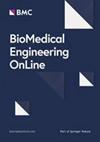结合机器学习的 CCTA 对预测右冠状动脉异常起源心绞痛的价值
IF 2.9
4区 医学
Q3 ENGINEERING, BIOMEDICAL
引用次数: 0
摘要
冠状动脉起源异常是一种常见的冠状动脉解剖异常。冠状动脉起源异常可导致冠状动脉起始部狭窄、走行异常等问题,从而可能因冠状动脉受压而导致心肌缺血。临床症状包括胸闷和呼吸困难,其中心绞痛是常见症状,可危及生命。及时准确地诊断冠状动脉起源异常非常重要。冠状动脉计算机断层扫描(CCTA)可提供有关冠状动脉特征的详细信息。因此,我们将 CCTA 和人工智能(AI)技术相结合,分析右冠状动脉起源异常患者的 CCTA 图像特征和临床特征,以预测心绞痛以及不同特征与心绞痛的相关性。在这项回顾性分析中,我们汇编了 126 名确诊为右冠状动脉起源异常患者的 15 项特征数据。数据集包括 CCTA 成像属性(如右冠状动脉口的位置和冠状动脉的排列)和临床参数(包括性别和年龄)。为了识别最显著的特征,我们采用了奇偶校验特征选择方法,该方法根据特征的统计意义进行筛选。然后,我们将重点放在奇平方得分超过 1 的特征上,从而将选择范围缩小到七个关键变量,包括心脏功能和性别。随后,我们评估了在分类任务中以高效著称的七种分类器。通过严格的训练和测试,我们进行了比较分析,以确定准确率最高的前三个分类器。本研究中排名前三的分类器分别是支持向量机(SVM)、集合学习(EL)和核逼近分类器。在基于 SVM、EL 和核近似分类器的分类器中,线性 SVM、可优化的集合学习和 SVM 核分别取得了最佳性能。相应的准确率分别为 75.7%、75.7% 和 73.0%。AUC 值分别为 0.77、0.80 和 0.75。机器学习(ML)模型可以预测右冠状动脉起源异常引起的心绞痛,为临床医生提供有价值的辅助诊断信息,并对临床医生起到警示作用。希望能实现及时干预和治疗,避免心肌梗死等严重后果。本文章由计算机程序翻译,如有差异,请以英文原文为准。
The value of CCTA combined with machine learning for predicting angina pectoris in the anomalous origin of the right coronary artery
Anomalous origin of coronary artery is a common coronary artery anatomy anomaly. The anomalous origin of the coronary artery may lead to problems such as narrowing of the coronary arteries at the beginning of the coronary arteries and abnormal alignment, which may lead to myocardial ischemia due to the compression of the coronary arteries. Clinical symptoms include chest tightness and dyspnea, with angina pectoris as a common symptom that can be life-threatening. Timely and accurate diagnosis of anomalous coronary artery origin is of great importance. Coronary computed tomography angiography (CCTA) can provide detailed information on the characteristics of coronary arteries. Therefore, we combined CCTA and artificial intelligence (AI) technology to analyze the CCTA image features and clinical features of patients with anomalous origin of the right coronary artery to predict angina pectoris and the relevance of different features to angina pectoris. In this retrospective analysis, we compiled data on 15 characteristics from 126 patients diagnosed with anomalous right coronary artery origins. The dataset encompassed both CCTA imaging attributes, such as the positioning of the right coronary artery orifices and the alignment of coronary arteries, and clinical parameters including gender and age. To identify the most salient features, we employed the Chi-square feature selection method, which filters features based on their statistical significance. We then focused on features yielding a Chi-square score exceeding a threshold of 1, thereby narrowing down the selection to seven key variables, including cardiac function and gender. Subsequently, we evaluated seven classifiers known for their efficacy in classification tasks. Through rigorous training and testing, we conducted a comparative analysis to identify the top three classifiers with the highest accuracy rates. The top three classifiers in this study are Support Vector Machine (SVM), Ensemble Learning (EL), and Kernel Approximation Classifier. Among the SVM, EL and Kernel Approximation Classifier-based classifiers, the best performance is achieved for linear SVM, optimizable Ensembles Learning and SVM kernel, respectively. And the corresponding accuracy is 75.7%, 75.7%, and 73.0%, respectively. The AUC values are 0.77, 0.80, and 0.75, respectively. Machine learning (ML) models can predict angina pectoris caused by the origin anomalous of the right coronary artery, providing valuable auxiliary diagnostic information for clinicians and serving as a warning to clinicians. It is hoped that timely intervention and treatment can be realized to avoid serious consequences such as myocardial infarction.
求助全文
通过发布文献求助,成功后即可免费获取论文全文。
去求助
来源期刊

BioMedical Engineering OnLine
工程技术-工程:生物医学
CiteScore
6.70
自引率
2.60%
发文量
79
审稿时长
1 months
期刊介绍:
BioMedical Engineering OnLine is an open access, peer-reviewed journal that is dedicated to publishing research in all areas of biomedical engineering.
BioMedical Engineering OnLine is aimed at readers and authors throughout the world, with an interest in using tools of the physical and data sciences and techniques in engineering to understand and solve problems in the biological and medical sciences. Topical areas include, but are not limited to:
Bioinformatics-
Bioinstrumentation-
Biomechanics-
Biomedical Devices & Instrumentation-
Biomedical Signal Processing-
Healthcare Information Systems-
Human Dynamics-
Neural Engineering-
Rehabilitation Engineering-
Biomaterials-
Biomedical Imaging & Image Processing-
BioMEMS and On-Chip Devices-
Bio-Micro/Nano Technologies-
Biomolecular Engineering-
Biosensors-
Cardiovascular Systems Engineering-
Cellular Engineering-
Clinical Engineering-
Computational Biology-
Drug Delivery Technologies-
Modeling Methodologies-
Nanomaterials and Nanotechnology in Biomedicine-
Respiratory Systems Engineering-
Robotics in Medicine-
Systems and Synthetic Biology-
Systems Biology-
Telemedicine/Smartphone Applications in Medicine-
Therapeutic Systems, Devices and Technologies-
Tissue Engineering
 求助内容:
求助内容: 应助结果提醒方式:
应助结果提醒方式:


